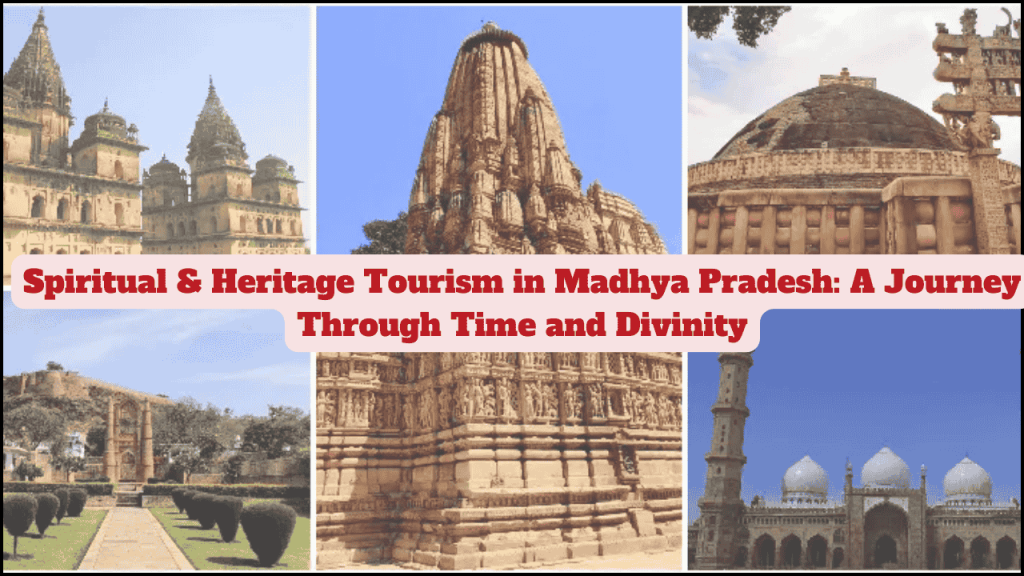
Madhya Pradesh, known as the “Heart of India,” is a land deeply intertwined with history, culture, and spirituality. Home to some of the oldest temples, sacred rivers, grand forts, and UNESCO World Heritage Sites, this state offers a divine experience for pilgrims and history enthusiasts alike. From the sacred banks of the Narmada to the stunning architectural marvels of Khajuraho, Madhya Pradesh presents a harmonious blend of spirituality and heritage.
The Sacred City of Ujjain: The Land of Mahakal
Ujjain, one of the seven Moksha-puris (holy cities) of Hinduism, is most famous for the Mahakaleshwar Jyotirlinga, one of the twelve sacred Jyotirlingas of Lord Shiva. It is here that the famous Bhasma Aarti is performed every morning, a sight that leaves devotees fascinated.
Key Attractions in Ujjain:
- Mahakaleshwar Temple – Dedicated to Lord Shiva, this temple is one of India’s most revered pilgrimage sites.
- Kumbh Mela – Held once every 12 years, Ujjain hosts the Simhastha Kumbh Mela, attracting millions of devotees worldwide.
- Kal Bhairav Temple – Devotees offer liquor to Lord Bhairav, a rare ritual seen in Hindu temples.
Omkareshwar: The Island of Divinity
Nestled on the banks of the Narmada River, Omkareshwar is a temple town shaped like the sacred ‘Om’ symbol. This makes it one of the holiest pilgrimage sites in India.
Why Visit Omkareshwar?
- Omkareshwar Jyotirlinga – Another one of the twelve Jyotirlingas, this temple sees thousands of devotees performing the parikrama (circumambulation) of the Om-shaped island.
- Mamleshwar Temple – An ancient temple with intricate carvings dating back to the 10th century.
- Narmada Aarti – Every evening, the Narmada River comes alive with the divine glow of diyas during the grand Ganga Aarti-style ceremony.
Khajuraho: A UNESCO World Heritage Site of Erotic Spirituality
Perhaps the most famous heritage site in Madhya Pradesh, Khajuraho is known for its exquisite temple carvings that depict love, divinity, and daily life in medieval India. Built by the Chandela dynasty between 950 and 1050 AD, these temples represent a fine balance between spirituality and human emotions.
Must-Visit Temples in Khajuraho:
- Kandariya Mahadev Temple – The largest and most intricately designed temple, dedicated to Lord Shiva.
- Lakshmana Temple – Known for its fine sculptures and carvings of gods, goddesses, and celestial beings.
- Parsvanath Temple – The largest Jain temple in the complex.
Despite their suggestive carvings, these temples symbolize spiritual enlightenment and human emotions, making them a wonder of world heritage.
Sanchi: The Epitome of Buddhist Heritage
If there is one place that encapsulates Buddhism’s spiritual essence, it is Sanchi, home to one of the oldest stone structures in India – the Great Stupa. Commissioned by Emperor Ashoka in the 3rd century BCE, Sanchi is now a UNESCO World Heritage Site and a prime destination for spiritual seekers.
What to See in Sanchi:
- The Great Stupa – Featuring intricately carved gateways (toranas) that depict the life and teachings of Buddha.
- Ashoka Pillar – The national emblem of India finds its origin in this pillar.
- Buddhist Viharas and Monasteries – Ideal places for meditation and understanding Buddhist philosophy.
Amarkantak: The Origin of the Sacred Narmada
Nestled in the Vindhya and Satpura ranges, Amarkantak is considered one of the most sacred pilgrimage destinations in India. It is believed to be the origin of the holy Narmada River, which is worshiped as a goddess in Hinduism.
Spiritual Spots in Amarkantak:
- Narmada Kund – The sacred pool from which the Narmada River originates.
- Kalachuri Temples – Beautiful 11th-century temples with intricate carvings.
- Sonmuda – The origin of the Son River, offering breathtaking views of waterfalls and forests.
Amarkantak is also a well-known Ayurveda and yoga retreat, attracting wellness seekers from across the country.
Maheshwar: The Spiritual Capital of the Holkars
Situated on the banks of the Narmada River, Maheshwar is a blend of history, spirituality, and royal legacy. It was once the capital of the Holkar dynasty, ruled by the legendary Rani Ahilyabai Holkar, who built numerous temples and ghats here.
Why Visit Maheshwar?
- Ahilyeshwar Temple – Built in memory of Rani Ahilyabai, reflecting Maratha architecture.
- Maheshwar Fort – Offers breathtaking views of the Narmada and houses a museum showcasing Holkar history.
- Handwoven Maheshwari Sarees – A perfect souvenir from the land of the Holkars.



